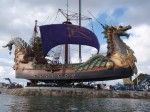 Some brief musings on the latest vaguely Narnia-themed theatrical treacle:
Some brief musings on the latest vaguely Narnia-themed theatrical treacle:
If you happen to like any linear combination of dragons and/or Art Nouveau, you should probably go see it. Treat it as a slide-show of visual wonders, occasionally interrupted by boring people talking.
I regard it as pretty absurd to talk about “spoilers” in the context of a work (ostensibly) based on a book that’s over fifty years old, and I don’t think I commit any. Nevertheless, here’s a cut:
I’m pretty sure things had gone badly off the rails when, during one meant-to-be-grim-and-suspenseful scene, a significant fraction of audience members involuntarily muttered “It’s… the Stay-Puft Marshmallow Man.”
Aslan was kind of a dick in the first two movies, and has not somehow become less of one in the intervening time leading up to this one. (On this point, oddly enough, the movies are quite true to the books. I doubt that’s the allegorical point C.S. Lewis was trying to make, but it is inescapable when one approaches the work with a jaded and cynical — and non-Christian — eye.)
Speaking of allegory, isn’t the whole point of it to be figurative and symbolic, to have things standing in for other things? In short, isn’t allegory by nature meant to be at least slightly subtle? I can count at least three instances (one fairly lengthy) where people in the movie actually dropped character to proselytize at the audience. (Something the books, for all their minor flaws, never did.)
 Many jokes were made in the car ride home concerning a series of children’s books written as an allegory for the Popol Vuh, where some whiny British kids fall through a magical laundry hamper into Xibalbá, and meet Vucub-Came (‘Seven Death’) who’s a talking jaguar or something.
Many jokes were made in the car ride home concerning a series of children’s books written as an allegory for the Popol Vuh, where some whiny British kids fall through a magical laundry hamper into Xibalbá, and meet Vucub-Came (‘Seven Death’) who’s a talking jaguar or something.
Still and all, the movie is pretty as all get-out. The ship and the various mythical creatures are the real stars of the show, and get a fair amount of screen time. If the two stock images I’ve attached to this post do anything for you, it’s worth your while to check it out.